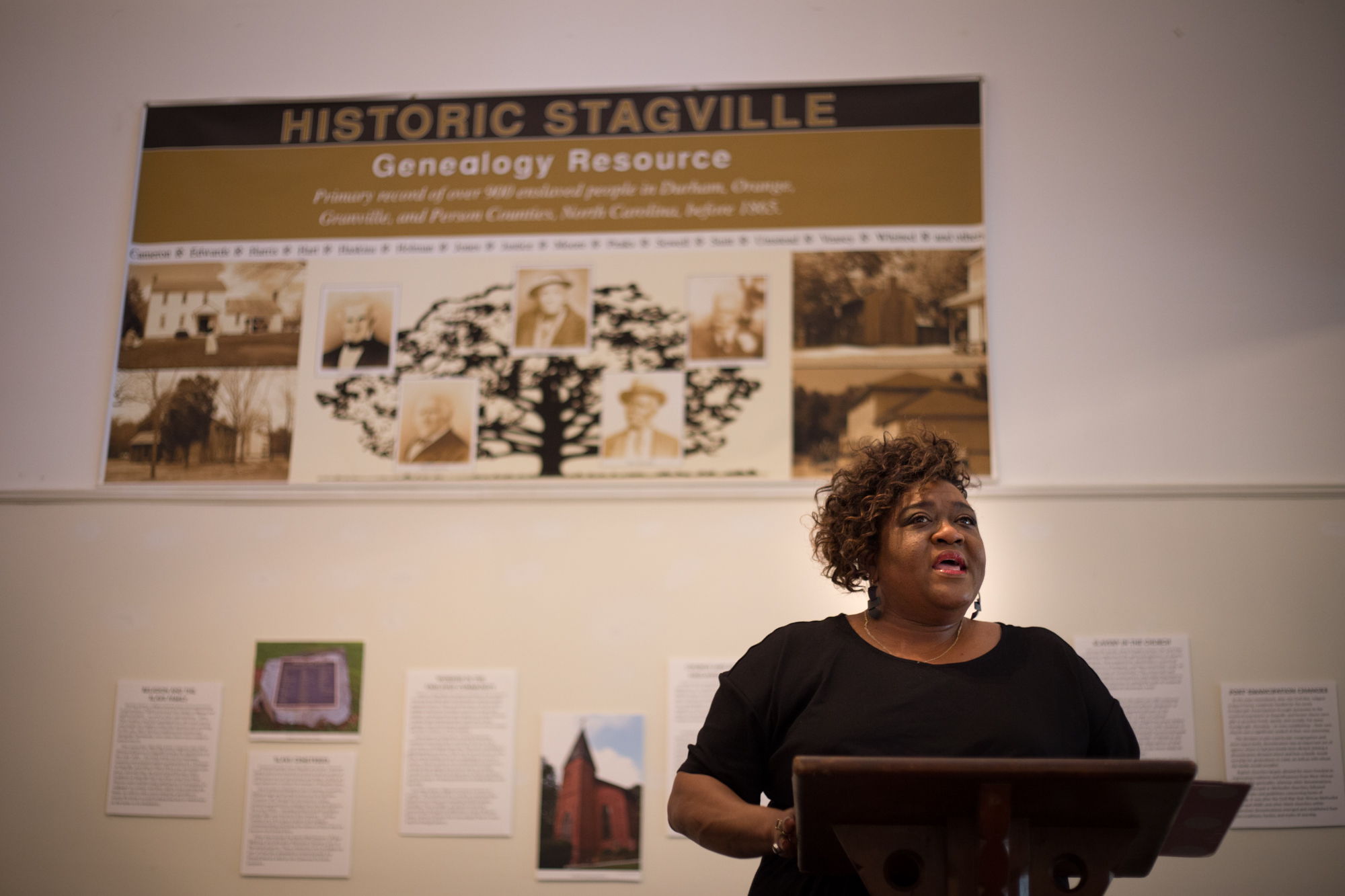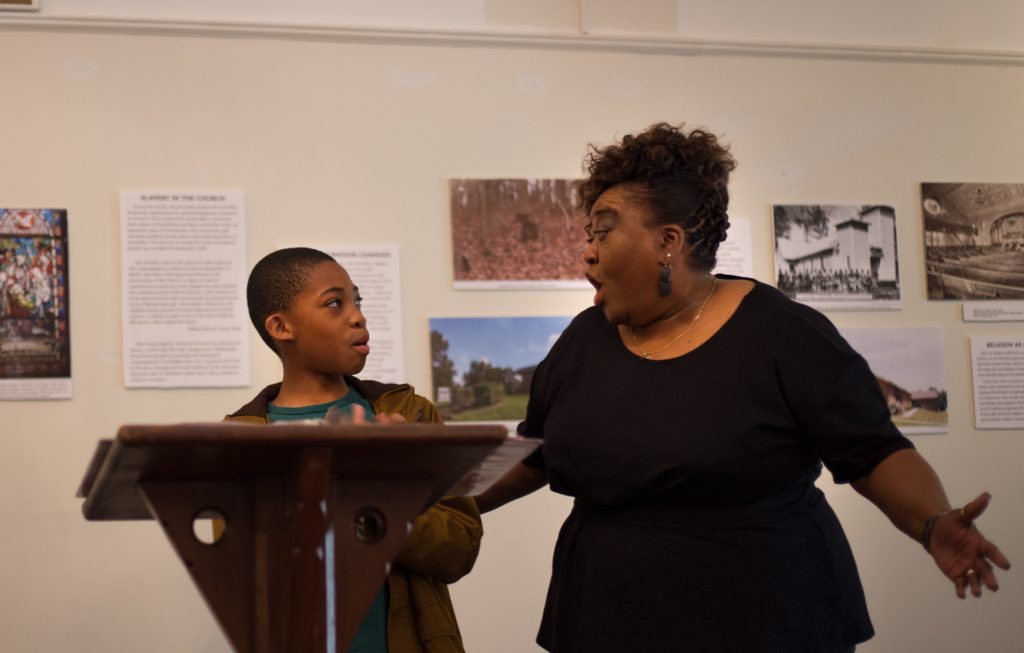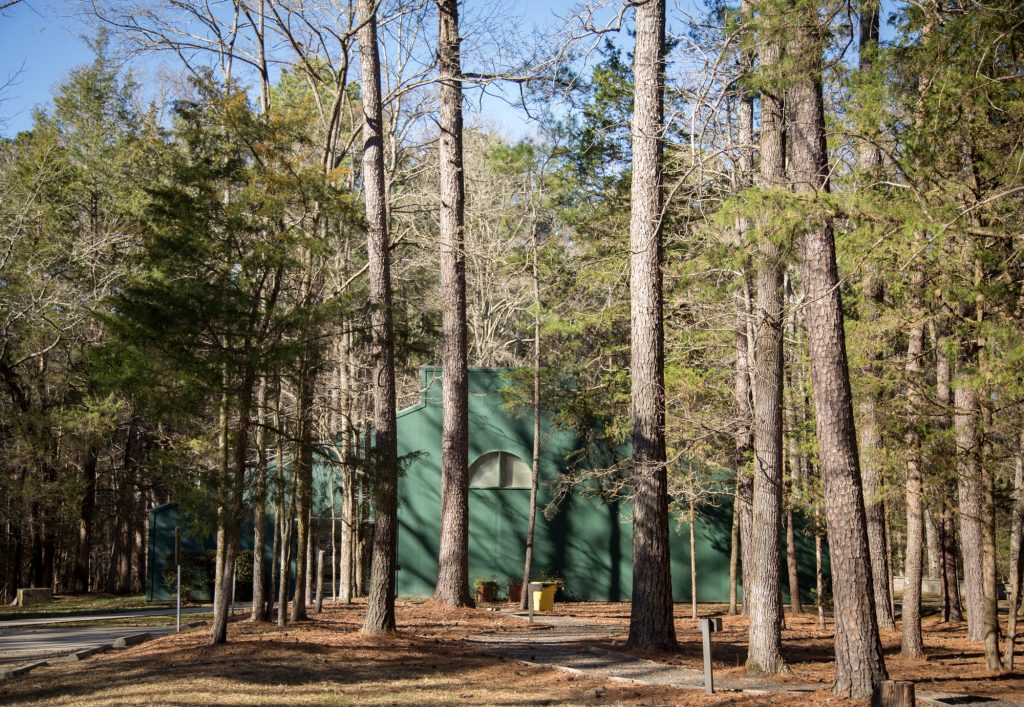
Mary D. Williams opened up her performance at the Historic Stagville visitor center with a discussion of the impact of Frederick Douglass, an abolitionist and activist on behalf of enslaved persons in the American south in the 19th century. (Staff photo Tenley Garrett)
It is not uncommon for the average American to be familiar with at least the idea of historic Southern plantations during the slave era of American history. But the reality of plantations and enslavement becomes slightly more unsettling when the truth is close to home.
Historic Stagville, home to one of the largest preserved plantations in North Carolina, sits just within Durham city limits. On March 3, Historic Stagville welcomed Mary D. Williams, a UNC alum and gospel singer, as she led audience members in a musical performance, “Songs from Slavery,” that might have reflected musical practices found on the plantation more than 150 years ago.

The Bennehan family home, probably built around 1787, which hosted the family when they moved to Stagville and founded the plantation. (Staff photo Tenley Garrett)
Williams’ performance combined historical accounts, personal anecdotes and song all in one throughout the roughly full hour of audience engagement. Many of the songs supported the “call-and-response” musical format, whereby Williams would sing a single line and allow for the audience members to repeat back to her, often accompanied by clapping or foot stomping with the rhythm. Williams said that although many scholars would call her work performance art, that does not convey its full character.
“I’m going to take you into my culture as an African-American and on behalf of the ancestors of African-Americans, and I’m going to take you on this journey from slavery up into the Civil Rights movement,” Williams said.
Her performance is especially significant this year, she said, because this year celebrates the 200th birthday of Frederick Douglass. In fact, most of her performance at Stagville focused on the life and memory of the Civil Rights activist and abolitionist whose experience is so well-recorded in his personal narrative, Narrative of the Life of Frederick Douglass, an American Slave.
But before any introduction was made, Williams marched slowly up to the podium, moving her eyes deliberately between each audience member while singing Angela Davis’s “Freedom is a Constant Struggle” in her deep, thunderous voice:
“They tell me freedom has been a constant struggle,
We’ve been struggling for so long…
We must be free.”
The agony and melancholy in her voice could be felt as it reverberated throughout the small room, filling each audience member with a somber sense of the struggle of which Williams sang.
Perhaps the most insightful piece of information Williams gave to her audience was regarding the operational and practical purpose that music served for many enslaved persons on plantations in the American South. Since enslaved people were forbidden to learn to read and write, songs became instrumental in communication and messaging across plantations, she said.
For example, Williams said the lyrics to “Wade in the water” have a figurative meaning which refers to the understanding of some enslaved persons that they had to cross a river in order to escape the plantation. The words “The Lord calls my name by thunder” to Williams can be deciphered in terms of symbol and metaphor. If “thunder” is taken to mean rain, Williams says that this wording indicates the understanding of enslaved persons that tracking dogs cannot properly hunt during a rainstorm, making this an ideal time to attempt escape. Similarly, songs like “Heaven on My Mind” likely referred to escaping the South, in addition to the expectation of a heavenly afterlife.
After singing songs pertaining to the time during which Douglass was enslaved, Williams then brought the audience to the Civil Rights era. She focused specifically on the incident in southwest Georgia where children, no more than 10 years old, were taken to jail in response to the freedom marches of the Albany Movement.
“I hear God’s children, they’re praying for mercy . . . Bells getting higher, buses are comin’, open them cells!”

11-year-old Jordan Hearsey joins Williams in leading the audience in song. (Staff photo Tenley Garrett)
One of the audience members, just 11 years old himself, joined Williams in leading the audience in song. The boy, Jordan Hearsey, said after the performance that he didn’t realize how important song was in communication for enslaved persons.
“I think it was great . . . I learned that [enslaved persons] used song to say that they were free, and the masters didn’t find out because they didn’t [understand],” said Jordan.
Beverly McNeill, a volunteer at the Historic Stagville site for more than 15 years, said she was thrilled by the performance:
“I thought it was really fantastic. She got a lot of good history in, and of course she’s a phenomenal artist,” she said.
Additionally, she said that the performance brought important moments in history to life for the modern audience.
“I think she makes history accessible, which I think is really important, because we don’t do a very good job teaching about this period,” said McNeill.

The historic Stagville Visitor Center can be seen through the trees as one enters the property. (Staff photo Tenley Garrett)
The site’s assistant manager, Vera Cecelski, has a history of knowing Williams and her music prior to her visit to Stagville. Aside from being a fan of her music as a teenager, Cecelski had the privilege of meeting Williams last fall on the Stagville property while Williams was conducting research as part of her scholarship.
“I knew that she had to come here and sing here and share it with a bigger crowd of people,” Cecelski said. Cecelski had led a tour of the property for a group of college students in addition to Williams, and it was on this tour that Williams’s work came alive to the visitors:
“We went down to the slave quarters at Horton Grove, and in one of those buildings, in that tiny dark room, she sang for the group of students… She was spontaneously moved by being in the space and feeling the energy of that space,” said Cecelski.
Williams’ voice, Cecelski said, brought life to an otherwise quiet, inanimate place:
“Her voice filled up the house and overflowed it and ran out the windows and just made the whole space come alive. And in that moment, as we were both walking out together we looked at each other and we realized she had to come back. More people have to hear this, the energy and the life that these songs bring to these spaces that, for the most part, can feel empty to people.”
For Williams, her passion for the musical practices and gospel songs that were so formative to the culture surrounding America’s slave past comes from her own upbringing and family.
“A lot of the music started with my grandmother just singing to me while I was spending time with them in Smithfield. And the more the music was sung, the more it resonated with me,” Williams said.
When she was young, unsurprisingly, Williams didn’t fully grasp the meaning of the words she sang. But she said that whenever she had a question about a song, her grandmother would share everything she knew as it related to their own family’s history. Today, Williams’ storytelling and musical performance illustrates an epic journey — one burdened by tragedy, trial and hardship, but all throughout — full of hope.
“It’s important to me to sing the songs of my ancestors — the songs that brought them to a place,” she said.
For a printer-friendly version of this story, click here.
____________________________________________________________
Want to give Mary D. Williams’ gospel voice a listen or learn about her work with “The South in Black and White”? Click here to listen, and here to learn about her scholarship. Find out how to visit Historic Stagville yourself by clicking here (free and open to the public).